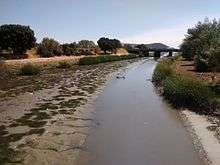Novato Creek
| Novato Creek | |
| stream | |
 Novato Creek in summer 2016 | |
| Country | United States |
|---|---|
| State | California |
| Region | Marin County |
| Tributaries | |
| - left | Bowman Canyon Creek |
| - right | Vineyard Creek, Arroyo Avichi, Arroyo San Jose |
| Cities | Novato, Bel Marin Keys |
| Source | Northeastern Marin County |
| - location | above Novato, California |
| - elevation | 1,100 ft (335 m) |
| - coordinates | 38°8′36″N 122°38′33″W / 38.14333°N 122.64250°W [1] |
| Mouth | |
| - elevation | 0 ft (0 m) |
| - coordinates | 38°5′43″N 122°29′18″W / 38.09528°N 122.48833°WCoordinates: 38°5′43″N 122°29′18″W / 38.09528°N 122.48833°W [1] |
Novato Creek is a stream in eastern Marin County, California, United States. It originates in highlands between Red Hill and Mount Burdell above the city of Novato, California, and flows 17 miles (27 km) before emptying into San Pablo Bay south of Petaluma Point.
History
Miwok and Pomo people were the earliest residents of the watershed. Olompali, the site of a significant Miwok village, is located at the southern base of Mt. Burdell. In 1839 Mexican land grants established Rancho Novato. Grazing brought a host of invasive annual grassland plants that eventually dominated the deep-rooted native perennial grasses and altered runoff rates.
By 1856 extensive apple orchards occupied the valley floor and many of the creeks had been channelized for irrigation. The tidal marshlands had also been diked and drained for agriculture (primarily oat-hay production) by the middle of the nineteenth century. In the 1880s the creek was dredged to make way for schooners bound for San Francisco.
Novato, one of the four townships in existence when Marin County formed in 1850, was incorporated in 1960. Ground was broken for Hamilton Air Force Base in 1932 and dedicated in 1935 (the base was decommissioned in 1974, and designated as a historic district in 1988).[2]
Land use changes have increased sediment supply and decreased sediment transport, causing the lower reaches of Novato Creek to become shallower. In addition, the construction of Stafford Dam (starting in 1952[3]) increased its drainage area by 5.2 square miles (13 km2).[4]
Watershed and course

The Novato Creek watershed basin is 45 square miles (120 km2). Novato Creek is joined (heading downstream) by six major tributaries along its 17-mile (27 km) length: Leveroni, Bowman Canyon, Warner, Vineyard Creek, Arroyo Avichi, Arroyo de San Jose, and Simmonds Slough.[2] Arroyo San Jose itself has two tributaries. It is joined on the left by Ignacio Creek and on the right by Pacheco Creek (at Pacheco Pond) just before entering Novato Creek. Novato Creek and its tributaries are often eroded, incised channels. It is one of the driest watersheds in Marin County.
Novato Creek begins to the west of Mount Burdell and initially descends to the west. However, it soon turns south, then east to feed into Stafford Lake. It descends through the city of Novato. East of Novato it crosses under U.S. Route 101 and State Route 37 before flowing through Bel Marin Keys and entering the northwest corner of San Pablo Bay.
Just before entering the Bay, Novato Creek flows along Bel Marin Keys, an affluent community on the creek and a series of adjacent lagoons, at an elevation of 10 feet (3.0 m) above sea level.
Ecology
Salmonids (steelhead trout (Oncorhynchus mykiss) and Chinook salmon (Oncorhynchus tshawytscha)) are also found within the Novato Creek watershed. The Novato Creek watershed is known to support 10 extant fish species (6 native and 4 introduced). Native species include California roach, Sacramento pikeminnow, Sacramento sucker, steelhead, threespine stickleback, and Prickly sculpin. Introduced species include rainwater killifish, western mosquitofish, striped bass, and green sunfish.[2] Fawcett (2000 and 2006) also noted the presence of non-native bluegill, largemouth bass, brown bullhead, chameleon goby, and inland silverside. Historically, the watershed supported native tidewater goby; the last collection occurred in 1945.[5]
Wetland-adapted species occur along Rush Creek and the lower Novato Creek wetlands. Noteworthy species include San Pablo song sparrow, California black rail, saltmarsh common yellowthroat, and California clapper rail. Western pond turtles and naturalized bullfrogs are known to occur in Novato Creek.[2]
Bridges

Novato Creek is spanned by many bridges, including:[6]
- at milepost 11.96 of State Route 37, a pair of 720 ft (219 m) prestressed concrete slabs built in 1959
- at milepost 20.51 of U.S. 101, a pair of 192 ft (59 m) concrete continuous tee beams built in 1974
- at Redwood Boulevard in Novato, a pair of 187 ft (57 m) concrete tee beams reconstructed in 1988
- at Novato Boulevard in Novato, a 98 ft (30 m) concrete continuous tee beam built in 1969
- at Seventh Street in Novato, a 60 ft (18 m) concrete continuous slab built in 1971
- at Simmons Avenue in Novato, a 36 ft (11 m) concrete tee beam built in 1932 and reconstructed in 1970
- at Grant Avenue in Novato, a 36 ft (11 m) concrete tee beam built in 1936
- at Sutro Avenue in Novato, a 33 ft (10 m) concrete slab built in 1935 and reconstructed in 1972
- at Diablo Avenue in Novato, a 32 ft (10 m) concrete slab built in 1966
See also
References
- 1 2 U.S. Geological Survey Geographic Names Information System: Novato Creek
- 1 2 3 4 "Novato Creek Watershed". Marin County. Retrieved 2010-08-31.
- ↑ "Novato History Museum". Archived from the original on 2007-12-26. Retrieved 2008-01-17.
- ↑ "Geomorphic Studies by Laurel Collins". Retrieved 2008-01-17.
- ↑ Robert A. Leidy (2007). Ecology, Assemblage Structure, Distribution, and Status of Fishes in Streams Tributary to the San Francisco Estuary, California (Report). San Francisco Estuary Institute. Retrieved 2010-08-31.
- ↑ "National Bridge Inventory Database".
